With the right water treatment, well water can be cleaner and safer to drink than city water. But well water isn’t regulated by the EPA, and the EPA doesn’t even provide recommendations for private wells – so, as a well owner, you’re much more likely to come across problems with your water compared to somebody who gets their water from a municipal supplier.
Untreated well water can have a poor taste, smell, or appearance, and contain contaminants that could affect your health. In this guide, you’ll learn which well water problems are most common, and how to treat them.
Table of Contents
💦 Hard Water
Hard water is one of the most common water issues in the US, affecting around 85% of the population. The hardness of your well’s water depends on where your well is located. Some regions have naturally harder water than others.

Symptoms
- Scale buildup in pipes and appliances
- White spotting on glassware and dishes
- Low water pressure due to the resistance from limescale in pipes
- Dry, flaky skin from washing in hard water
- Rough, discolored clothes from doing laundry with hard water
Effects
The effects of hard water are long-lasting and worsen over time. You’ll notice scale buildup on your sinks, faucets and bathtubs, which is difficult to clean away with standard cleaning methods. Scale buildup also shortens the lifespan of appliances and reduces their efficiency. Your appliances will require more electricity to operate and won’t last as long as they should.
Although hard water minerals aren’t dangerous to drink, they can aggravate skin problems like eczema, and affect your skin and hair health in the long run.
Solutions
The easiest way to treat hard water is with a water softener or water conditioner. Water softeners and conditioners prevent scale formation, either by removing hardness minerals from water or altering the composition of these minerals, preventing them from sticking to surfaces. A water softener is installed at your home’s point of entry, before the hot water heater, providing softening benefits throughout your home.
💨 Hydrogen Sulfide or Iron Bacteria
Hydrogen sulfide is a natural gas that occurs in rocks and soils beneath the earth. The gas decomposes and ends up in well water supplies. Hydrogen sulfide doesn’t typically affect the appearance of water, but it can cause water to smell and taste like rotten eggs.
Iron bacteria is caused when bacteria and iron in well water combine, producing a thick, slimy substance. Sulfur bacteria is a similar well water problem that occurs when hydrogen sulfide and bacteria combine.
Well water smells like sewage? Find out out to fix it here!
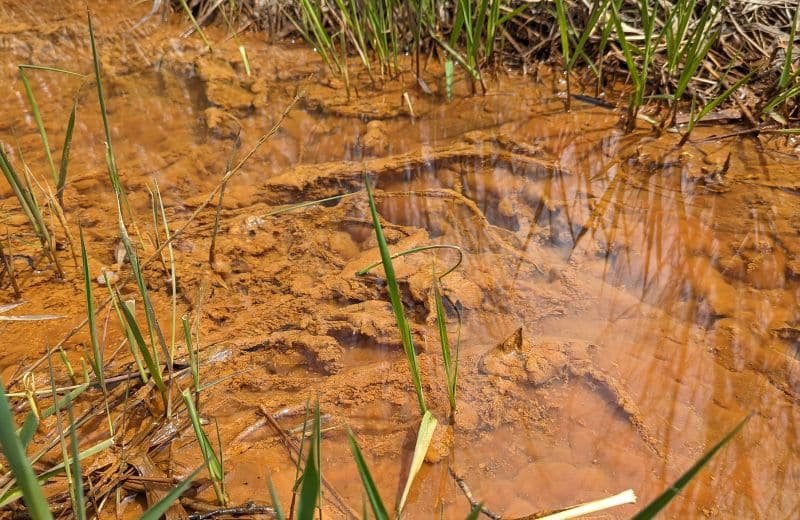
Symptoms
The symptoms of hydrogen sulfide are:
- A smell or taste of rotten eggs in water
- Stained clothes
- Discolored fixtures and cutlery
- Corrosive pipe damage
The symptoms of iron or sulfur bacteria are:
- Clogged pipes
- Premature corrosion of well components
- Slime-like substance in toilets and sinks
Effects
The biggest issue with hydrogen sulfide is that it’s a corrosive contaminant, so it can corrode the inside of your plumbing and cause materials like copper and lead to leach into your water. If hydrogen sulfide builds up in small spaces, such as wells, it can pose an explosion risk. Hydrogen sulfide also tastes unpleasant in water.
Iron bacteria isn’t typically unsafe to drink, but this bacteria can have negative effects on your plumbing. Iron bacteria builds up in any standing water source, including your toilet bowl, and can reduce well yield and clog plumbing. Iron bacteria can also give water a poor taste and smell.
Solutions
To treat hydrogen sulfide and iron bacteria, your best bet is to use a combination of well disinfection and air injection. Well disinfection will eliminate the bacteria in the short term. In the long term, you can remove hydrogen sulfide with an air injection system that uses manganese greensand or a similar media, trapping the gas and converting it into an oxidized form that can be removed via filtration.
🌑 Iron, Manganese & Tannins
Iron, manganese and tannins are three of the most common naturally-occurring impurities in well water. Iron and manganese are minerals that are found underground in rocks and soils. Tannins are caused by decomposing vegetation and get into water that seeps through the earth. None of these impurities are dangerous to drink, but they can have damaging effects in your home.
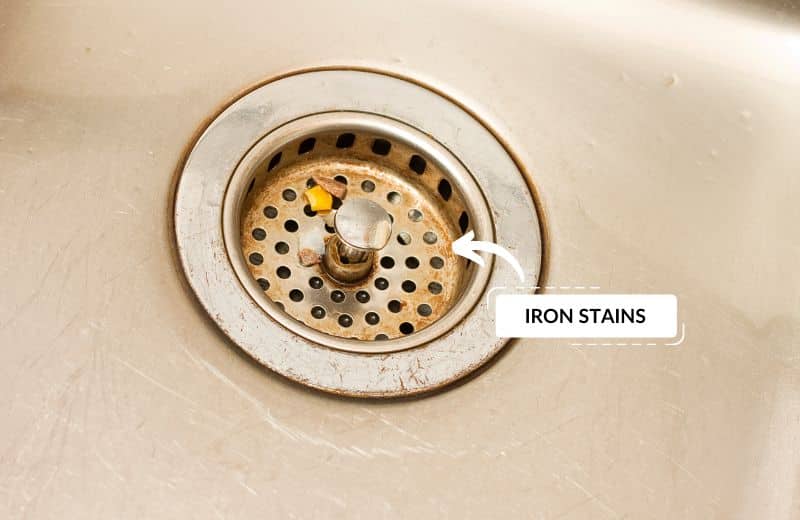
Symptoms
- Dirty-looking, orange-tinged water
- Stained clothes, porcelain fixtures and cutlery
- Orangey-gold flecks in water
- Red, orange or brown stains in sinks, toilets and bathtubs
- Bitter, metallic-tasting tap water
- Black or gray stains
- Oily sheen on water’s surface
Effects
Iron, manganese and tannins leave similar-looking stains in your plumbing and toilet tank, and on your laundry and fixtures. A high quantity of either of these minerals can give water an unappealing orange or cloudy color. Iron gives water an unpleasant metallic taste.
Solutions
The simplest way to remove iron and manganese is to use an air injection or chemical oxidation system. This system will oxidize iron and manganese, then trap them in a media bed (usually birm or manganese greensand). A common method of removing tannins from well water is to use an anion exchange resin.
💠 Fluoride
Fluoride is added to public water supplies, but this mineral is naturally-occurring and can end up in wells, too. Fluoride is good for dental health, but ingesting high quantities of fluoride – higher than the EPA’s recommended MCL of 0.7 ppm – can be dangerous.

Symptoms
- Dental fluorosis, characterized by stained teeth
- Skeletal fluorosis, resulting in bone development problems
Effects
Measured amounts of fluoride don’t cause health problems. However, drinking high quantities of fluoride can be dangerous, especially in young children. Dental fluorosis usually affects children under eight years old and alters the appearance of the tooth enamel. Skeletal fluorosis is caused by an accumulation of fluoride and results in painful, weakened bones.
Solutions
Fluoride is particularly tricky to remove from tap water, and not all standard filters can target this mineral. Reverse osmosis is one of the only guaranteed methods of removing fluoride, although other filters using a carbon-KDF media blend can offer fluoride removal, too. Because fluoride doesn’t damage the plumbing in your house, you can use a point-of-use reverse osmosis filter to treat just your drinking water.
🌪️ High Turbidity
High turbidity, or suspended sediment, can get into your well if your well is poorly designed, faulty, or not properly sealed. Drilling, runoff, and similar disturbances can also cause turbid well water. High sediment levels can also be warning signs that you have well water problems beyond water quality, such as pollutants, microbial contaminants, and oxidized metals.
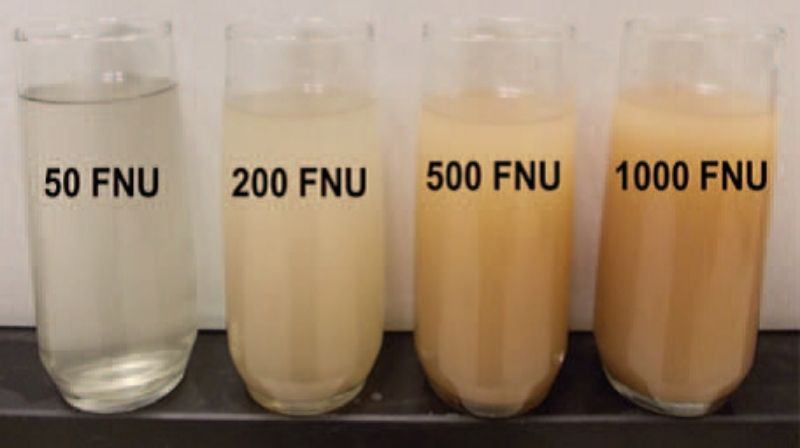
Symptoms
- Cloudy-looking tap water
- Visible sediment in water
- Dirty water
Effects
Turbidity alone isn’t usually a dangerous problem, despite its effect on water quality. However, drinking water containing turbidity is usually risky because turbidity often goes hand-in-hand with other more harmful contaminants, like microbes. If your water contains these contaminants, you could end up with a bacterial or viral infection.
Solutions
Treating high turbidity alone is easy – just use a point-of-entry sediment filter. However, this form of water treatment won’t protect you against microbial contaminants. You’ll need a UV filter or a chlorine injection system to protect your water well from these impurities.
🦠 Coliform or E.coli Bacteria
Coliform bacteria are found in fecal matter from animals and humans, and can get into your well water supply through cracked well walls, overflowing septic tanks, and runoff from agricultural activity.
You might not expect coliform bacteria to be one of the well water problems that would affect you, but a 2006 study of 450 wells says otherwise – coliform bacteria was found in around 35 percent of wells. E. coli is the second-most common bacteria, and was found in about 15 percent of private wells.
Related: Learn all about bacteria in well water
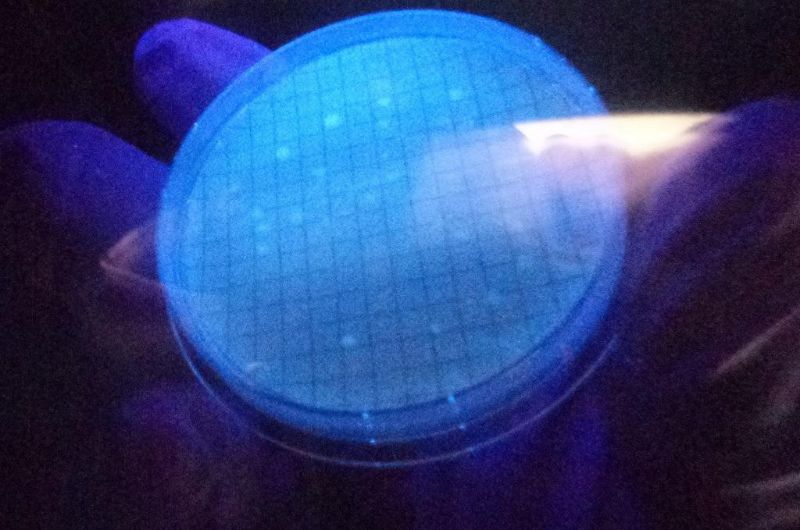
Symptoms
- Gastrointestinal illness in anyone drinking your water
- Potentially (but not always) a bad odor
Effects
Coliform and E.coli present no warning signs but have near-enough instant effects, unlike many of the common well water problems on this list, which build up to harmful levels over time.
If you consume water containing any of these bacteria, you’re likely to experience symptoms including nausea, sickness, diarrhea, abdominal cramping, and fever. Symptoms present as quickly as within the day of drinking water contaminated with bacteria, and can last for up to 10 days.
Solutions
To kill existing bacteria in your water well, you’ll need to shock the well with chlorine. (Here’s our guide on how to do this if you’re unsure.)
To protect your water going forward, use a UV purification system or a chlorine injection system to disinfect your water supply.
📉 Low Water Pressure
Significantly lower-than-usual water pressure is usually always caused by a failed well pump. If your water pressure is only a bit lower than normal, you might just have scale in your pipes, caused by a hard water issue.
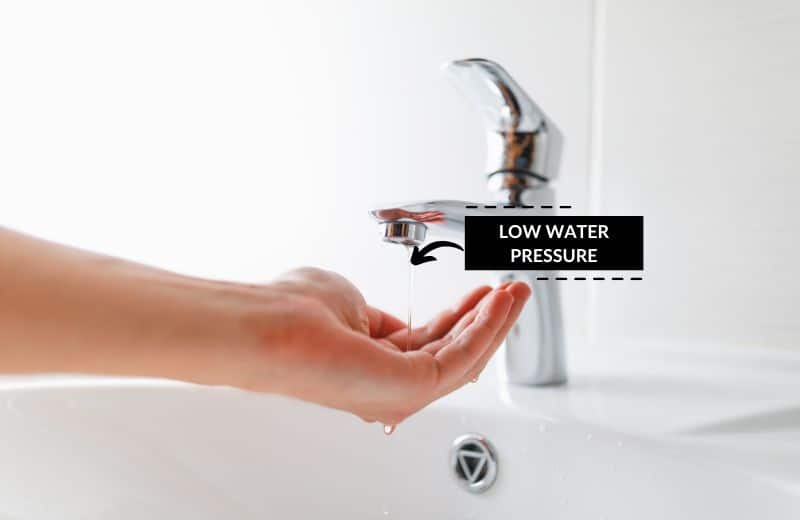
Symptoms
- Reduced water flow from your showerhead and faucets
- Inefficient appliances
- Inability to use multiple appliances at once
Effects
Water pressure well problems can cause a reduced amount of water to move through your home’s pipes and plumbing. As a result, every activity that involves water, including washing your hands, taking a shower, and using water-based appliances, becomes a much longer process.
In some cases, if you use several appliances at once, the water supply to one appliance might cut off entirely. Linked to this, you may end up paying more on your power bill to run the well.
Solutions
The solution to this problem depends on the cause. To check to see if your well pump is the issue, make sure the breaker for your pressure and well pump is switched on, then take a reading from the pressure gauge for the well pressure tank. It should read a minimum of 20 psi. If the pressure is below this, it’s likely that the pressure tank, well pump, or pressure switch is faulty.
If the well pump continues to operate without starting and stopping, you may have a break in the line. If you notice a spark when the pump kicks in, you’ve got a problem with the pressure switch.
Once you know the cause of the problem, you can arrange to get it fixed by a private well installer.
Related: Costs to replace a well pump in 2024
Occasionally, a water pressure problem can be caused by a lack of water in the water table. In this case, you’ll need to arrange for your well to be assessed by a professional.
If your water pressure problems are simply caused by hardness minerals, a water softener will solve your issues.
📥 Low pH (Acidic Water)
Low pH, or acidic water, is another of the most common well problems. Acidic water is usually caused by acid rainfall and plant decomposition, which leaches acidity into groundwater as it seeps into the well aquifer. Low pH can also be caused by mining activities and low TDS (total dissolved solids) in drinking water.
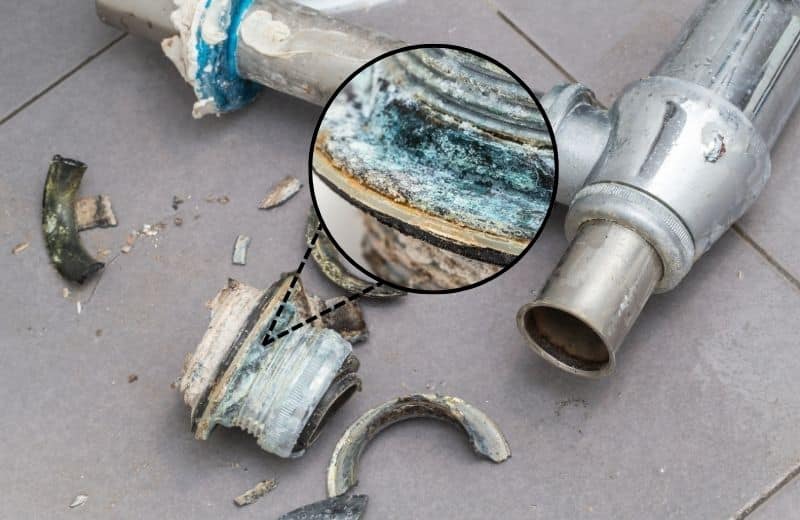
Symptoms
- Blue-green stains on your fixtures and appliances
- Pinhole leaks (tiny holes) in plumbing
- Metallic-tasting water
- Corrosion on metal pipes
- Potentially increased lead, copper, and metal quantity in water
Effects
Acidic water isn’t usually dangerous itself, but the effects of acidic water could be harmful. Water with a high acidity causes corrosion in metal plumbing, so your drinking water could end up containing worrying amounts of metals, like copper and lead.
Corrosion can eventually cause pinhole leaks in your pipes. Although pinhole leaks aren’t typically catastrophic, if you don’t notice these leaks, you’ll end up wasting money and water. Signs of low pH include metallic-tasting water and blue-green stains on your faucets and fixtures.
Solutions
If you’re dealing with low groundwater pH, you may need a soda ash injection system or acid-neutralizing filter. These systems will raise your water’s pH by introducing alkaline minerals to the water. You may also need to replace your metal plumbing with BPA-free plastic pipes.
Be aware that pH can affect the performance of some well water treatment systems, like reverse osmosis filters and water softeners. You’ll need to treat the pH issue before treating other problems with your water.
📰 How to Prevent Well Water Problems
You can prevent well water problems by installing one or several suitable water treatment systems for your water well. There are plenty of systems to choose from, depending on your purpose.
Whether you want to improve your water quality, remove health-concerning contaminants, or improve the taste and smell of your well water, a well water treatment system (or a combination of two or three) will provide the results you need.
Regular well maintenance will make troubleshooting common problems much easier. When you perform maintenance on your well, you’ll know how your well’s components (the pressure tank, switch, submersible pump, and so on) should behave when they’re operating properly. This will make it easier for you to determine whether a water quality issue is caused by a problem with the well itself.
You won’t know that you have any problems unless you test for them, so it’s important to test your water routinely to make sure you uncover potential health concerns that you’d otherwise be unable to detect. The CDC recommends testing your water well annually for nitrates, bacteria, pH levels, and total dissolved solids, as well as testing for any other water quality issue that you’re concerned about.


You got my attention when you said that hard minerals in water could lead to eczema and other skin-related issues. My sister is planning to have her water well repaired because its motor stopped working this morning. Since she has been complaining about frizzy hair and dry, itchy skin, I will ask her to think about your tips.
Right on! Thanks for sharing